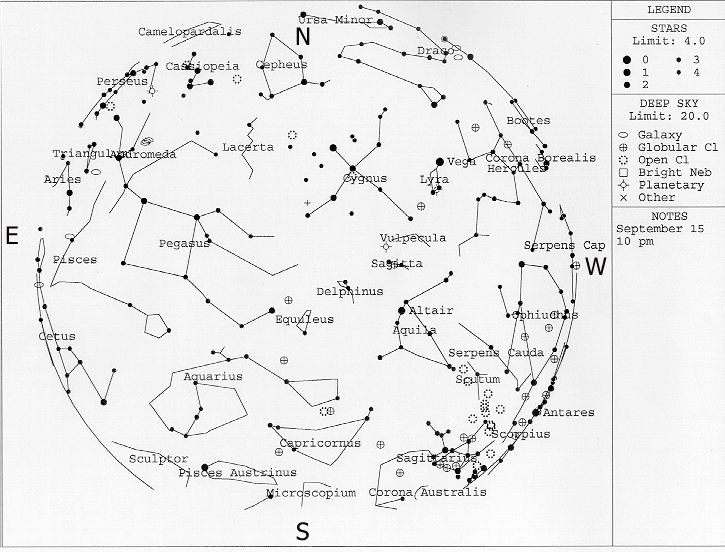What's to see in the night sky in September?

This chart represents the sky as it looks at around 10 PM local
time. Some adjustment should be made for longitude, but it shouldn't be much. Right click on
the chart, select "Save As" and save the image. You can then print
this chart from a photo application, like Print Shop Pro, hold it in front of you with the
direction you are facing at the bottom. Then, raise it above your head and you should be
able to find your way around from there.
Moon phases
New-9/11_____First Quarter-9/19____Full-9/26____Last Quarter-9/3
Planets
Mercury won't be seen this month-too close to
the Sun. It's moving slowly away from the Sun at sunset, but doesn't get
very far above the horizon due to the tilt of the ecliptic.
Venus will be the brightest thing in the sky
before sunrise in September. Look to the east and you can't miss it!
Mars will be rising earlier and earlier during
September, but isn't very close this year. Watch for him in Taurus, near
the circle of Auriga.
Jupiter hangs out in Ophiuchus all month, crossing
the meridian as the Sun sets, moving slowly eastward as the month progresses.
Saturn will be all but lost in
the Sun this month, too. But you may catch him in Leo's lap between midnight
and dawn toward the end of the month.
Meteor showers
Delta Aurigids peak at 10 ZHR on 9/8.
Deep Sky Objects (DSO's)
Messier Objects
Globulars M2, 15, 30, 72 and 75, the best being M2 and 15. Both are right around 6.5
magnitude and large enough to see in binoculars. M29, 39 and 73 are open clusters, with 29
and 39 in being the only ones really worth a look. (M72 is only 4 stars in Capricornus.)
Both are fairly large, with M39 having more stars and more of a distribution of magnitudes.
I'd call it "interesting and fairly rich".
Strictly speaking, there are no PN's visible
from Messier's catalog, but no one will squawk if you sneak another peek at M27 again. :-)
Named DSO's
The most obvious named DSO's up now are the Veil Nebula-a supernova remnant in Cygnus, the
North American Nebula-an emmision nebula, also in Cygnus, the Pelican Nebula-right next to
"Florida", and the Crescent Nebula-a reflection nebula that looks like part of a PN, but isn't,
the star involved is known as a "Wolf-Rayet" star, which is basically a very high energy
emmitting star that's lighting up the gas around it.
Actually, the whole area around
Gamma Cygni, the center star in the "cross", is rich with open clusters, dark and bright nebulae
and is a wonderful place to go "binocular surfing". Enjoy!
Here's the link to SEDS as promised.
| January's page | February's page | March's's page | April's page | May's page | June's page |
| July's page | August's page | September's page | October's page | November's page | December's page |

Copyright 1999, Steve Dodder
Webmaster: Steve Dodder
Revised: 7/22/03